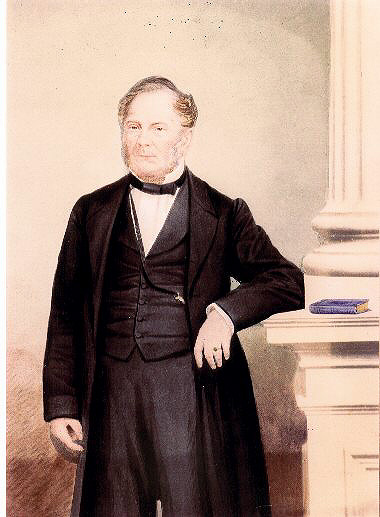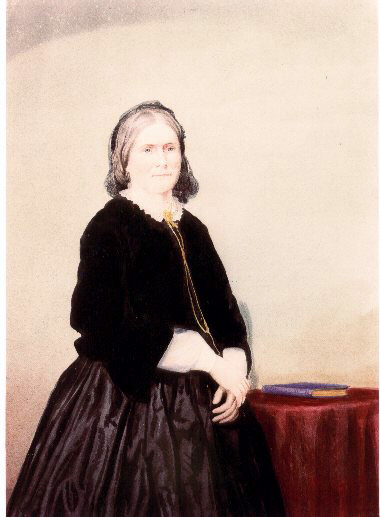 Life
Before Australia: Life
Before Australia:
DAVID OGILVY 1804-1871
Composed from notes given to his a great grand son Colin
Darby of Armidale.
David Ogilvy is Son of parents David Ogilvy (who was a Painter in
Edinburgh) and Catharina Spence. He was born Edinburgh in 26th June 1804.
He was apprenticed on the 26th June 1832 to Robert Macmillan at the Signet
(Solicitors), studied Law and became a writer to the Signet; his offices
were in Castle Street North, looking straight up to Edinburgh Castle,
which was now a rooming house. Sir Walter Scott used to walk down to
David’s house each morning carrying his little Jeanie in his plaid to
say “good Morning” to his friend David Ogilvy.
He continued the Ogilvy tradition of naming the eldest son - “David”
and had a ring with the Ogilvy Crest “A Portcullis” on it.
Life
in Australia:
DAVID OGILVY 1804-1871
Composed from notes given to his a great grand son Colin
Darby of Armidale.
David Ogilvy came from Scotland to Australia in 1839 and settled in
Prahran Victoria. He was one of the Ogilvy Clan (The House of Arlie).
David was appointed by the British Government to represent the Crown in
legal affairs in Victoria, he was the first president of The Law Institute
and President of The Presbyterian Church of Victoria, and a passenger in
the first train that ran in Victoria.
 His
offices were in Queen Street Melbourne. His name appears in the Law list
of 1847 as a Solicitor. He became the first president of the Law Society.
On the 9th September 1841 he married Elizabeth Aitchison Williamson
(Daughter of James Williamson of Trinity Scotland) at Scots Church,
Heidelberg and went to live in Punt Road – South Yarra on a site now
known as Witchwood Close. He called his house “Airlie Bank”. A copy of
the original photograph is now in the Royal Historical Society of
Victoria. It was the second house built in South Yarra – Colonel
Anderson’s being the first – and gave the name to Airlie Street. He
owned the land, ten acres, which extended from Domain Road down to the
Yarra River and planted it with grape vines – bringing out a Frenchman
to make wines; I have a photograph of the vineyard. This quote is from
“Early Prahran Settlers”. “Ogilvy not only grew grapes and made wine
but sold rooted vines and cuttings of choice sorts through the auctioneers
W. M. Tennent & Co., who claimed that Ogilvy’s "red hermitage
was celebrated". His
offices were in Queen Street Melbourne. His name appears in the Law list
of 1847 as a Solicitor. He became the first president of the Law Society.
On the 9th September 1841 he married Elizabeth Aitchison Williamson
(Daughter of James Williamson of Trinity Scotland) at Scots Church,
Heidelberg and went to live in Punt Road – South Yarra on a site now
known as Witchwood Close. He called his house “Airlie Bank”. A copy of
the original photograph is now in the Royal Historical Society of
Victoria. It was the second house built in South Yarra – Colonel
Anderson’s being the first – and gave the name to Airlie Street. He
owned the land, ten acres, which extended from Domain Road down to the
Yarra River and planted it with grape vines – bringing out a Frenchman
to make wines; I have a photograph of the vineyard. This quote is from
“Early Prahran Settlers”. “Ogilvy not only grew grapes and made wine
but sold rooted vines and cuttings of choice sorts through the auctioneers
W. M. Tennent & Co., who claimed that Ogilvy’s "red hermitage
was celebrated".
He later built “Airlie” on the corner of Domain Road and Punt Road. It
is now a Police Academy who has provided the following history of the
property. “In 1850 the land on which Airlie is built was by law in the
Parish of South Melbourne. On the 21st May 1846, under an old system of
titles known as ‘General Law System’, a Crown grant for Crown Portion
of 8 Parish of South Melbourne County of Bourke in the Port Philip
District was issued to David Ogilvy. The grant covered about ten acres
from Clowes Street to Domain Road, having frontage of 5 chains to both
streets and twenty chains frontage to Punt Road The grant was signed by
Sir George Gipps, Governor in Chief of Territory of New South Wales, at
Government House, Sydney on the 21st May 1846. About
1858 the land was deemed to be in Prahran and finally about 1870 it was
declared to be in South Yarra. Upon
his death, the land passed to his widow, Elizabeth Ogilvy. In 1886 she
applied for and was granted a modern Certificate of Title for the whole of
Crown Portion Eight with the exception of a block 143ft X 200ft at the
corner of Punt Road and Domain Road. She directed that the certificate
issue in the same name of David Whitely to whom she sold the land in 1885
for (pounds) 15.000. In 1888 she sold the residue (the piece 143ft x 200ft
to Thomas Hall for (pounds) 10.000. He
was an elder of Scots Church and now a quote from an extract from “The
History of the Presbyterian Church of Victoria by the Rev. Robert
Sutherland 1877.”
“Mr David Ogilvy was an Elder of the Scots Church and a gentleman of
high integrity. He represented the Presbyterian Church on the Education
Board of the Colony and at a time when his hours were very valuable, he
gave his services for the public good, he was also Treasurer for the
Presbyterian Church of Victoria and when he left Melbourne on a visit to
his land of his fathers, a public dinner was given to him by the leading
gentlemen of Melbourne.” He
took a pioneers interest in development of Prahran and was one of the
first members of the Deaf and Dumb Institution. He was instrumental with
the late George Coppin in starting the Old Colonists Homes. At
the end of each year he made a donation of a tenth of his income to
charities; this was in addition to donations he made during the year. He
and his wife had seven children; five sons and two daughters, David, James
Williamson, Alexander John, John William, Isabella, William, Elizabeth and
they all attended Cairns Memorial Church in East Melbourne. In the Church
is a plaque, which reads –
“To the memories of David Ogilvy, Esquire, an old colonist, eminent for
his natural gifts and spiritual graces; revered by all relations of life,
a husband and father, wise, tender and affectionate, as a Lawyer, as a
citizen, foremost in every good work, as an elder of this congregation and
of the Presbyterian Church of Victoria, distinguished by scrupulous
attention to every duty, by prayerfulness and self-denial, by humility and
meekness, by a ready and generous liberality, by zeal for the glory of
god, by compassion for the souls of men. To him, to live was Christ, to
die was again”. It was
a custom of my great grandfather never to use his carriage and coachman on
a Sunday saying it was a day of rest. So he and my great grandmother and
their brood walked down Punt Hill to the Yarra to take a punt across. If
going to church the punt man was not permitted to charge passengers, but
my great grandfather insisted on paying. His
sons entered Scotch College on the day it opened, coming from Lawson’s
Academy. My great
grandfather retired from his profession and went on a visit to Scotland.
He returned to the colony in 1864 and left again in 1870 in the steamship
Queen of the Thames. On the passage she was wrecked at The Cape of Good
Hope. He remained at the Cape for a month “suffering great hardship”
when he succeeded in booking his passage to London. He died on the 7th
July 1871, in Edinburgh in the 67th year of his age. Again
I Quote from Reverent Robert Sutherland 1877; -
“The news of his death was received with deep regret at Melbourne and a
minute bearing testimony to his great worth and valuable services was
inserted in the records of the General Assembly.”
Inserted by Colin Darby (Great
Grandson of David). |

